12
DEAD MAN WALKING
Living Evidence of Ancient Races
Man still bears in his bodily frame the indelible stamp of his lowly origin.
CHARLES DARWIN, THE DESCENT OF MAN
SWAMPED
Mayan anthropogenesis makes the apt observation that remnants of each World Age survive to the present moment. Yes, early hominid traits still linger—we carry forward even some of the most ancient genes.
Every person alive today has both Druk and Ihin lineage in them.
VERNON WOBSCHALL, OAHSPE STANDARD EDITION
Once crossbreeding is taken to heart, we will be gratefully relieved of the many inconsistencies and difficulties that assail paleoanthropology, including how to explain extinctions; now we can look to EBAs (extinct by amalgamation). How did Neanderthal disappear? Was he wiped out? Is he really extinct? “It is doubtful,” thought Ashley Montagu, “whether [Neanderthal] was exterminated anywhere. The truth seems to be that he mixed with whatever populations he encountered and in the course of time was absorbed by such populations.”1 Here we come full circle with “the Neanderthal problem,” which is a problem only if we ignore the nookie factor. Montagu made that statement in 1957; it took another fifty-four years for experts to reluctantly concede: “Perhaps they were eliminated by interbreeding with us”2 (2011). Still, Neanderthals, according to most evolutionists, were “replaced” by Homo sapiens. But they bred with H. sapiens and disappeared, not really through replacement, but largely through absorption (EBA) into Cro-Magnon groups.
The second wave of Ihuans, the Aurignacians (produced, if you recall, 39 kya) also went EBA, just as they had done in the first round, ca 70 kya—by back breeding. It was, in short, the retrobreeding of Ihuan with Druk, both before and after the flood, that gave us the various Neanderthaloid types. In a way, EBA is similar to the genetic concept of swamping: if Neanderthals crossbred with mods, such as Cro-Magnons, ca 35,000 years ago, their disappearance can be attributed to interbreeding. They were swamped. Hooton was right: “I think they were absorbed.”3 C. Loring Brace was wrong: “Nothing but modern skeletal material is evident since about 35,000 years ago”4—which, as we’ve seen, has been blown out of the water by younger specimens proving EBA, such as the mixed types in Portugal, Romania, Croatia, Czechoslovakia, France, and Spain.
More recent EBAs might include the following cases:
- Dolicocephaly in Europe (swamped by race mixtures with brachycephals from the East) was not changed by mutations, but by EBA.
- The Bushman race (except at Kalahari) have been absorbed by the “Cape coloured” people, a mixed people of southern Africa.
- Mandan and other North AmerInd groups, the Wai Wai pygmies of British Guiana, and many others were absorbed into larger groups, as were most of the Yaghans of Tierra del Fuego and Chono Indians of Chile.
- The Native Hawaiians became so interbred with immigrants to their islands that they have almost vanished as a distinct people.
- The Ainu of Japan are headed in the direction of EBA, driven out, absorbed, or destroyed.
- The original Negritos of Australia, according to J. B. Birdsell, were entirely absorbed by the Murrian people; just as today, the remaining Tasmanians are all of mixed blood.
- The aboriginal stock of New Zealand’s Maori were absorbed or destroyed.
NEANDERTHAL: MISSING, PRESUMED DEAD
It was long believed that the coelacanth fish became extinct 70 mya, since their fossil remains do not show up in deposits after that time (Cretaceous). But they are not extinct after all: folks at Comoro Islands, off the South African coast, fish for it and eat it. Likewise did nineteenth-century attempts to dredge up life from the sea, in Norway’s fjords and along the Atlantic coast of Britain, reveal that some sea creatures thought to be long extinct still live on the ocean floor. Other “living fossils” include the tuatara (a reptile that, like the coelacanth, was not known since the Cretaceous), Neopilina (mollusk, since Devonian), Lingula (shellfish, since Ordovician), and Metasequoia (redwood, since Miocene).
This subject reminds me of a recently published story about a boy lifted and dropped by a huge bird, the extraordinary scene witnessed by six individuals, including the boy’s mother, who said the bird looked like a giant condor, with a wing span about ten feet. Predictably, the experts declared the incident impossible, despite other thunderbird types sighted in Illinois, Pennsylvania, and Tennessee, which seem to resemble the extinct teratorns, made famous by their remains at California’s La Brea tar pits.5
Numerous studies, moreover, have uncovered evidence of man living at the same time as some of the “bygone” Tertiary beasts: pottery at Tiahuanaco, for example, is adorned with pictures of a Toxodon, supposedly extinct for a million years.
As you may have noticed, the extinction date for Neanderthal is a shifty thing, forever moving closer to recent time. At first, the Neanderthal race was said to have disappeared around 140 kya; Hooton (before 1950), changed that to 72 kya. Then in 1960, Le Gros Clark made it 50 kya; and by the 1980s it inched up another 10,000 years to 40 kya.6 That was whittled down to 35 kya soon after; and with new finds at Zafarraya, Spain, it went down another notch, to 33 kya. Then in 1988 Neanderthals’ extinction date was made even later—32 kya.7 No sooner was that established than finds at St. Cesaire, France, and Mladec, Czechoslavakia, knocked it down to 31 kya (these were mosaics, actually, mixed Neanderthal and modern, some with big brows and projecting faces). Even so, it has been further bumped down to 28 kya, after a hard look at Croatia’s Vindija cave specimens; and, in the year 2000, experts move the final Neanderthal “extinction” to 27 kya.
But it dropped again to 26 kya, with Predmosti men discovered during renewed digs in the Moravian region; although they try to pass them off as Cro-Magnons, clearly they were mixed with Neanderthals—their dolichocephalic skulls showing orbital ridges and heavy brows. And if they were indeed Neanderthaloid Cro-Magnons (these people did work in ivory), the cannibalism discovered here (bones heavily charred) is a telling sign of Cro-Magnon back breeding and retrogression.
But wait, we now have 24-kyr Neanderthaloids, with the 1998 Portugal finds, thousands of years after the supposed Neanderthal extinction, not to mention 18-kyr Neanderthals at Girona, Spain, and at Amud I (Galilee) and yet other Neanderthals said to date less than 6000 BP!8 How reliable are our concepts of or dates for racial extinctions?
Flores’s controversially archaic (but chronologically recent) hobbit was found to be alive and well just 12 kya, which made some observers think that sightings of Yeti-like creatures might indeed have a grain of truth. Maybe cryptozoology could come in from the cold after all. The cryptid Sasquatch/Yeti is described as having long arms reaching to the knees—like hobbits and the Asuans of old, and indeed like most early men: Au, H. habilis, H. erectus, and Neanderthal. Long arms, even today, are retained by some groups of H. sapiens pygmaeus, such as the Andamanese, Malaysian Negritos, Aetas, and Veddas; in India, a visitor to Bengal in 1824 reported seeing short-statured wild tribes, their arms extremely long, reddish hair on their skin.
WHATEVER HAPPENED TO HOMO ERECTUS?
In every major race, both erectus and sapiens forms were represented.
CARLETON COON, ADVENTURES AND DISCOVERIES
Just as Mr. and Mrs. Neanderthal lasted a lot longer into the Mesolithic (and perhaps the Neolithic) than is supposed, Mr. and Mrs. Erectus*147 also survived so late in time that they seem to have coexisted not only with the Neanderthals but even with Cro-Magnons.9
The western Pacific (Micronesia’s Caroline Islands) holds a rich vein of prehistoric cave remains bearing an extinct population of little people: twenty-five miniature humans, with erectoid features, who lived as recently as three thousand years ago on the rock islands of Palau.
Excavated by a National Geographic team in July 2006, these little Palauans, together with their hobbit cousins on Flores, have been the center of a hot scientific debate since their discovery. The tiny Palau specimens, like hobbit, had small faces, large teeth, and a wide gap between their eyes (rather like the feral, completely wild, and extant Orang Pendek of Sumatra). Fairly chinless like hobbit but larger brained, the little people of Palau have caused much head scratching; anthropologist Lee Berger and his team were perplexed by Palau man’s (supposedly surprising) mixture of traits, some of which (reduced chin, vertical depth of jaw) scientists thought of as prehuman.
But what is so perplexing about the blend of traits, which pervades every single branch of the family tree? While our little people of Palau do indeed have a hard time fitting into a smooth evolutionary picture, they go right along with the rest of mankind in demonstrating a mixed gene pool. A wonderful hodgepodge of traits. Call it what you like—crossbreeding, interbreeding, hybridization, or amalgamation—such racial mixing has been going on since the beginning.
If these erectoid Palauans were here as recently as 1400 BP, when did the Druk or H. erectus race actually die out? If we go shopping for H. erectus dates, there is an ample selection to choose from: The experts tell us that they went extinct 120 kya, or was it 400 kya? Gone from Africa, others say, 500 kya; or was that 300 kya? In more recent books we are likely to hear that they vanished only 60 kya, which agrees with Le Gros Clark’s date of H. erectus in the Far East less than 60 kya. H. erectus is getting younger all the time, like Ndandong Man of Java, with recent evaluation of teeth done of course since the upsetting hobbit find (in 2004). Other Javanese skullcaps of H. erectus are dated as young as 28 kyr—a far cry from his supposed extinction 500 kya. But old habits die hard and even current books (say, Brian Switek’s 2010 book Written in Stone) put the H. erectus die-off at 200 kya. Something is definitely wrong with these dates. Jeffrey Goodman’s chart on page 165 of The Genesis Mystery lists H. erectus specimens dated as recent as 10 kya!
Histories drawn from Oahspe (Druks persisting up to the time of Zarathustra, 8 kya, when they intermarried with Ihuan’s, and the long-nosed ground people, hoodas/Druks, living in Arabinia until around 5 kya10) seem to score a match with findings in Australia, where recent H. erectus groups date anywhere from 40 to 6 kya: the Mossgiel cranium from New South Wales, the Cossack skull from western Australia, the Cohuna cranium of Victoria, the Talgai cranium of Queensland, and, finally, the Kow Swamp specimens of Victoria.11 These robust Kow Swamp people are only 10 kyr, notwithstanding their certifiably archaic appearance: receding skulls, continuous torus, massive jaw and brow, big teeth, large erectoid face. A spot of controversy here: Since their femurs are perfectly modern and since the continent of Australia supposedly has never had but H. sapiens types upon it, therefore the Kow people must be H. sapiens if only because the out-of-Africa theory says H. erectus never made it to the nether continent, which was “colonized”
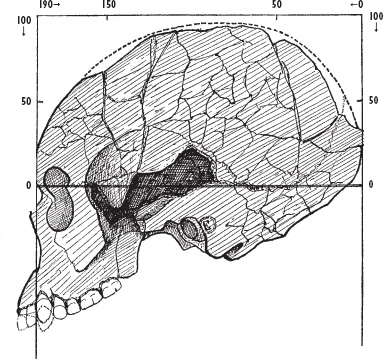
Figure 12.1. The Talgai skull belonged to a recent Australian H.erectus, dated to about 12 kya, the low-vaulted cranium discoveredat Talgai near Brisbane. Talgai Man is similar to today’s Aboriginesin the face (prognathous), dentition (canines), forehead (sloping), andpalate. But the Talgai skulls are above the average dimensions of modabos, though the glabella and eyebrow region are very thick and thepalate, according to Keith, “anthropoid.” Mixed genes are the onlysolution to all such “mysterious” combinations.
But that can’t be right. Those Kow crania had both H. erectus and early H. sapiens features: the forehead was flat like mods, but it was sloped. The lower face was prognathous and the cranial vault thick; yet the skull is basically modern, with straight sides. So theorists pulled the isolation card: invoking the separateness of the island continent, evolutionists tried to explain (away) Kow as “peripheral isolates”—a remnant population.
That didn’t work, though, when the same kind of people were found two thousand miles away on the west coast of Australia: the Cossack material. This archaic morphology was not a regional freak but continental in distribution. And when they tried to explain that away by nonevolutionary factors, such as inbreeding, cranial deforma-tion, anemia, malnutrition, “the admission that one or more of these [nonevolutionary] factors could produce a Homo erectus–like morphology is also an admission that the concept of human evolution [itself] is not needed to explain that morphology.”12 Or any morphology.
DEAD MAN WALKING
Archaic traits in living races puts paid to evolution and extinction, indicating instead the steady absorption of bygone groups into the main-stream of the more modern phenotype. Some members of all of today’s races, thought George Frederick Wright, show archaic traits. For example:
- France still has a remnant of the large Cro-Magnon who supposedly died out about 11 kya: the tallish, ruggedly handsome, dark-skinned people of the Dordogne Valley, possessing the peculiar Cro-Magnon skull form.
- The platycephalic (low-domed) skull of early man is still evident in some people of Holland and England.13 Skull shapes in mid-Wales also show some Stone Age measurements. Some Lapps and Finns have the (Neanderthaloid) occipital bun. The dolichocephaly of many North Europeans is also an archaic leftover.
- Marcellin Boule found the Paleolithic Grimaldi skull type among some modern people of Italy, “explained by the facts of atavism.”
- According to Franz Weidenreich, Java’s Pithecanthropus and H. soloensis agree with today’s Australian Aborigines in details such as strong browridges, receding foreheads, and angular skulls. Australian and Tiwi Aborigines show a low cranial vault with some keeling at the top of the skull (sagittal crest); Tasmanian and Australian abos are similar to 13-kyr Keilor Man of Victoria.
- Weidenreich also noted a certain continuity that bridges Peking Man (Sinanthropus) with today’s Mongolian populations, who also share a short tibia with Neanderthal. Peking Man’s upper incisors were shovel shaped, as found in almost all of today’s Mongoloid peoples. According to Chinese archaeologists, Peking Man’s skull has some characteristics shared by modern Chinese people, particularly the low nose bone and flat cheeks.
- Inuits and Aleuts also compare with Peking Man in thick mandibular torus and robust cheekbones. Peking Man’s bony out-growth at the inside of the lower jaw is found in most of today’s Lapps and Inuit. Laplanders and Greenlanders also have a heavy overarching brow and the nonoverlapping, edge-to-edge teeth bite of earlier races. A vestigial sagittal crest (bony ridge along the top of the head, as in Zinj) is found among some AmerInds, Inuit, Chinese, and Australians.
- Mincopies (Andamanese) bones are pretty thick with conspicuous muscular impressions; they share with the Bushman and Khoikhoi the archaic trait of steatopygia (bulked up hips and buttocks).
- Bushman nails are considerably curved like Lucy and some habilines who had curved hands and feet, which helped in tree climbing. Other unusual or archaic traits among the Bushmen include labia majora and knob nipples, not to mention the primeval wide-set eyes.
- The Mbuti of Zaire are pygmies who “in stature, brain capacity, and even way of life, are comparable to Homo habilis.” Yet the Mbuti “are modern men in every sense except that they do not watch television documentaries nor receive grants from science-funding bodies.”14
- The Ona Indians of Tierra del Fuego are of primitive appearance in their low sloping cranial vault. Fuegans and Patagonians (recent skulls) show the jutting browridge and some sagittal keeling.
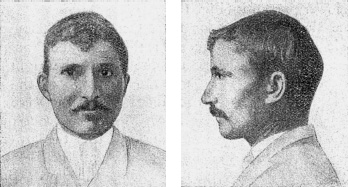
Figure 12.2. Modern man of Dordogne retains his Cro-Magnon heritage. It is also thought that today’s Basque people are morphologically the same as 20-kyr Cro-Magnon Man.
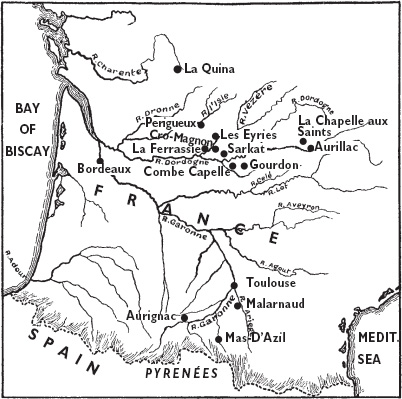
Figure 12.3. Map of prehistoric sites in the Dordogne region of France.
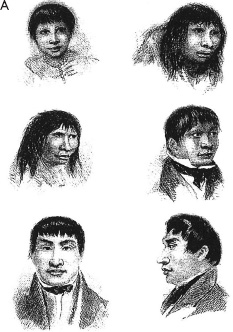
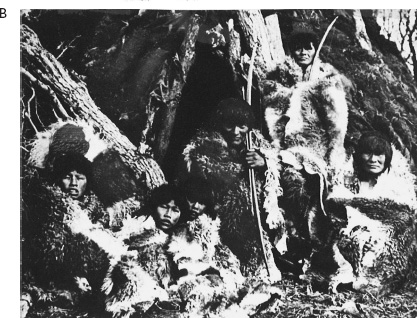
Figure 12.4. (A) Tierra del Fuego people drawn by Captain Fitzroy, Darwin’s superior on the HMS Beagle. Three of these Fuegans were brought back to England and presented to the Queen. (B) Fur-clad Ona Indians of Tierra del Fuego in the 1890s.
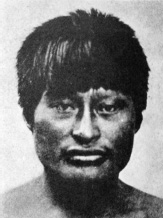
Figure 12.5. An Ona Indian.
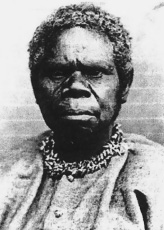
Figure 12.6. This woman, Trugannie, was one of the last of the full-blooded Tasmanians (1875).
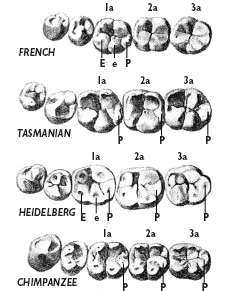
Figure 12.7. Tasmanian molar, compared to lower molars of chimpanzee, Heidelberg Man, and a modern Frenchman.
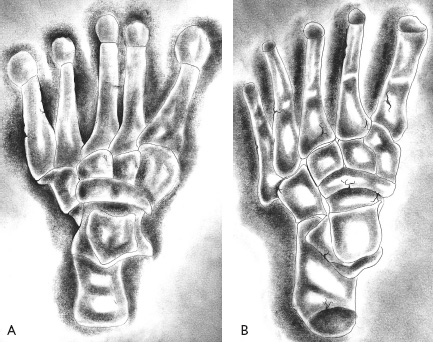
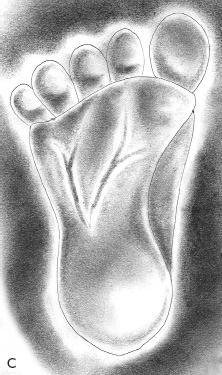
Figure 12.8. Splayed big toe as seen in: (A) Olduvai Au child (B) modern Bushman (C) Italian Neanderthal. A feature of the archaic body plan, the divergent big toe is extant in the gene pool of H. sapiens: Bushman, Negrillos, Veddas, and Malaysian Negritos possess the big toe projecting sideways. The feature was suited to the tree-climbing, branch-grabbing early races, such as the australopiths (Au. afarensis, Sterkfontein, OH 8, etc.). Next in line to inherit the divergent digits was H. habilis; then, Neanderthal; then Chancelade man of the Magdelenian—all seen with the divergent great toe.
Thomas Henry Huxley felt that those recently discovered Neanderthals (at Feldhofer, 1856) were little more than an extension back in time from the living Australian Aborigines, the latter regarded in Victorian times as the most brutish of living humans. Australian and Tiwi prognathism, large teeth, and depressed nasal root appear to be holdovers from Neanderthal.
Speculation about extant Neanderthaloids did not end with the Victorians. A recent issue of The Barnes Review highlights the work of Stan Gooch, who said that Jews can trace “integral components” of their heritage to the Neanderthals who, he maintains, were not destroyed by the Cro-Magnon culture but were incorporated into it through interbreeding.15 Indeed, at the end of the Paleolithic, the Ghans back-bred with the Druks, accounting for Neanderthal traits in Neolithic mods of the Middle East and beyond.
Gooch went on to speak of a Neanderthal race still living in Central Asia today, contradicting out-of-Africa enthusiasts who assure us that Neanderthals went extinct long ago, without issue, and with no particular relationship to moderns, for they were “completely replaced.”16 Modern Asian features have also been compared to late archaic hominids, the beaky Neanderthal face, for example, still notable among the living people of India and peripheral Mongoloids such as the Nagas of Assam. Some anatomists have remarked that the splayed big toes and nasal cavity of today’s Bushman are the same as Neanderthal’s, as is the molar formation of the Bantus. In addition, Congoid people typically have the distinctive Neanderthal occipital bun (protuberance at back of head),17 which is also found among the Finns and Basques. It seems that other aspects of the Neanderthal cranial type persist in today’s Europeans, some of whom “bear the traces of their remote Neanderthal ancestry . . . in their rather heavy browridges, deep-sunk eye sockets, receding foreheads and weakly-developed chin,”18 seen especially among Nordics, as noted by Hooton and Sir William Turner, anatomist. According to Arthur Keith, “traits which may be called . . . primitive are of frequent occurrence . . . still among South Europeans.”19 Indeed, the likelihood of extensive hybridization in the Mesolithic makes it less surprising that some Central Europeans today have in their posterior skull, femur, and nose a structure reminiscent of Neanderthals.
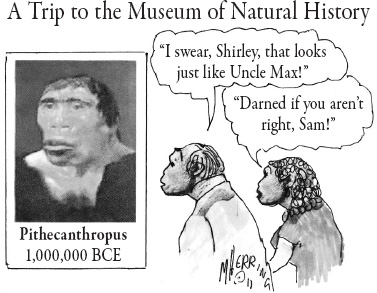
Figure 12.9. Shirley and Max. Cartoon by Marvin E. Herring.
HOMO FERUS
The first amalgamation that got the ball rolling, the Ihin-Asu match of old, was only the beginning: many forbidden matings were to follow, and some of the resulting hybrids did not entirely disappear. Roman historians alluded to “wild races”—were they Neanderthals? And what about today’s acclaimed Sasquatch of the Northwest or Yeti of the Himalayas? The abominable snowmen, a hirsute race of humanlike giants, are neither bears nor apes, their faces coarse but manlike, with sad expressions. Some analysts think Yeti might be a relict Sinanthropus (Peking Man), having survived in the inaccessible Himalayas and in parts of Central Asia. Jim Dennon portrayed Bigfoot as a subhuman creature, 82 percent beast—the largest hominid. Carleton Coon wrote in his autobiography, Adventures and Discoveries, “I am sure that both these bipedal primates [Yeti and Sasquatch] exist.” In China, Coon heard stories about wild men, covered with hair, seen in the Yellow River Valley; there have been similar reports from Kiang-Si province.
Cryptozoology is an active and valid field, probing cryptids like the Almas of Central Asia (Gooch’s Neanderthals?) and their cousins in the Caucasus, Azerbaijan’s white-haired Kaptar. Cryptozoologist Loren Coleman has followed these unknowns among AmerInd, Asian, and African tribes, folk traditions about them going back thousands of years. Usually described as possessing erectoid-like features, such as short legs and long arms, cryptids have also been depicted with bull necks, fanged canines, and heavy browridges, answering in every detail to the (supposedly extinct) hominids of the Paleolithic.
We see hundreds of species in our modern world who are in fact survivors of previous Earth epochs.
VINE DELORIA JR., RED EARTH, WHITE LIES
White skinned and black haired is the rumored “ape man” of Africa’s Gold Coast—reputedly fourteen feet tall,20 (these giants perhaps related to the unknown makers of the enormous biface tools found in southern Morocco). On the short end of Africa’s spectrum is the man-beast of Tanzania, called Agogwe, a russet-furred manimal, who authorities speculate might be a survival of Homo erectus, not unlike cryptids seen in Zaire, Sudan, and Senegal. When these odd “little men” called Agogwe*148—reported by many credible witnesses and also an intrinsic part of tribal lore—first came to the attention of academia, they were considered some sort of missing link.
Twice as Tall?
Hand axes from sites in Ethiopia, Morocco, and Syria (at Ain Fritassa and Sasnych) are “far too large” (ten pounds and more) to be hand-held by people of today’s world; the bifaces from Agadir, Morocco, weigh in at 17 pounds, and their use requires the finger spread of a 13-foot tall man. Ordinary flint tools of the same type weigh less than a pound. They certainly suggest a bygone race of much greater size. “Mortals became twice the size of men today . . . an imperfect giant stalk . . . and the time of generation of mortals had risen. Many lived to be 300 years old.”*149 Theopompus knew of people twice as big as normal men, and they lived double our age. Explorer and author David Hatcher Childress, on Nan Madol in the Pacific, learned of a human femur found in the jungle that was twice as big as a normal man’s.
But the only thing “missing” is a frank understanding of crossbreeding: sexual congress enjoyed by the disobedient Ihuans with the ground people, the most common type of exogamous unions documented in these chapters. Africa, thought Loren Eiseley, “like other great land areas, has its uneasy amalgams.”21 It was here, in 1888, that Henry Morton Stanley encountered pygmies with “fell” over their body, almost feathery; just as the first white men to meet Africa’s Twa people in the nineteenth century said their whole body was covered by thick hair, almost like felt. To this day there are pygmy tribes among whom infants are born with reddish lanugo.
The early progenitors of man were no doubt once covered with hair.
CHARLES DARWIN, THE DESCENT OF MAN
Other furry tribes include the hairy Ainu of Japan. Caucasoid and modern though they are, the Ainu yet retain the extreme hairiness of the archaic type. (They themselves must be Darwinists, for they claim their furriness came from their ancestor, the bear!) One story out of China recalls the Chou Dynasty’s brain trust (twelfth century BCE), one member of which was so hairy that no one could see his skin (see figure 12.10).
We are aware of some strange creatures of this type quite a bit closer to home. Jacko for example, seen by a huntsman in British Columbia, was a pint-sized fellow who “resembles a human being” but is covered with glossy hair and has extraordinarily strong arms.22 Bernard Heuvelmans (Mr. Cryptozoology) reported on another wild type known as didi in Venezuela and British Guiana, who answers to the description of Jacko; short and powerful, with human features and reddish brown fur, didi resembles, in turn, the Sisemite of Central America, who are covered in black hair, which grows almost to the ground.
BATS, BATAKS, AND BATUTUTS
First man, Asu, with his long arms and hairy body, left a few genes to the atavistic Bat people of Brazil, as well as to other groups of absolutely wild men, Homo ferus—all considered dead ends on the human family tree. But a few did survive.
In the iconography of our forebears, such beings with hairy bodies, deformed bones, snarling fanged mouths and claws are not sym-bols of anything or the mythic fantasy of unschooled people; rather are they remembrances of the monstrosities that were not corrected until Apollo’s time, eighteen thousand years ago.23 A few probably survived to a much later date, though deeply ensconced in the hidden places of Earth.
A. F. R. Wollaston described a relict people he encountered during his daring expedition to New Guinea’s interior a hundred years ago: small, short-legged, broad-faced, short-skulled, and very hairy, the description reminding us a bit of the Bogenah tribe still living in the heart of Panama’s Guaymi country: very short, extremely primitive, and rather like the early races with their strong, bowed legs, long arms, large hands and feet, low and receding foreheads, flat and bridgeless noses. Other explorers of Panama have documented “an animal which appeared . . . to be a cross between a [human] . . . and a gigantic ape . . . [it] walked erect, weighed possibly 300 pounds and was covered with long black hair. . . . The Indians from Ecuador to Nicaragua assert that [such] creatures inhabit isolated jungle-covered mountains.”24 Among these little known races are Ecuador’s shiru (four and a half feet tall and fur covered) and the little dwendis of Belize, no taller than four feet, well proportioned but hairy with rather long arms and yellowish faces. Loren Coleman has documented and illustrated various relict pygmy types: hairy and swift, like Mexico’s alux, sehite, and sedapa, most with thick black or red fur and an “ancient look to their face”; very capable tree climbers, they are naked and give off strange vocalizations.
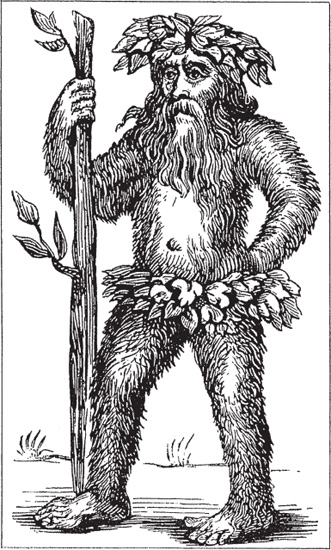
Figure 12.10. A European conception of a wild man. Note his short stature and shaggy coat of hair, probably akin to the hairy dwarves (farfadets) featured in the folklore of France and the classical Irish grogach, hairy and naked (unlike the clothed and civilized leprechauns).
Even though Asu man is long extinct, his genes live on in all of us, though most notably in remote groups who, not intermarrying with outsiders, kept recycling some of that ancestor’s genes. Remnants of hairy, brutal, and cannibalistic people still exist in the interior of South America, and they are greatly dreaded. Known to the Spanish as Cabelludos (hairy ones), to the Portuguese they are Morcegos (bats), based on their custom of hiding during the day and hunting by night. The Indians call them Tatus, or armadillos, from their Druk-like way of burrowing in the ground, in holes about twelve feet in diameter, roofed over with branches.*150
Pliny the Elder, in the first century, furnished details about the “dreadful dwellers” of the Sahara, troglodytes who had no language but “batlike squeaks” and lived in holes in the ground—as the Matmata of Tunisia apparently still do. The Yaks also burrowed in the ground “like beasts in the forest.” Relict creatures answering this description may still be around. Some Negritos in Malaysia know of a group called Batak, said to live around the headwaters of the Plus, who are cannibals and dwell in “burrows in the ground.”
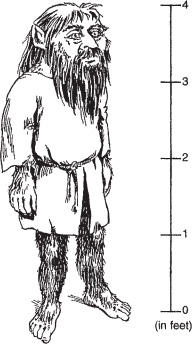
Figure 12.11. Alux of Mexico. Courtesy of Loren Coleman, author of The Field Guide to Bigfoot, Yeti, and Other Mystery Primates Worldwide (1999).
The 1889 Proceedings of the Royal Geographical Society reported on a wild man, perfectly nude, captured in Madagascar while asleep in the branch of a tree. He resisted capture violently, a powerfully built man, his body thickly covered with long black hair. Possessed of a strange gait, he traveled very fast, sometimes on all fours. After a few weeks in captivity, he began to communicate; it seems he had a father and brother in the forest, and when the authorities went to capture them, they “jumped from tree to tree like monkeys.” The poor captured man died five months later.
Here in Madagascar near the erstwhile home of the noble Vazimba (white pygmies), wild men, small of stature (called kalonoro) are known to inhabit the woods around the Marojejy Mountains, deep in the forest. Frightening and bizarre (hafahafa), they have long flowing beards and glowing eyes. Whence came these awful little men? We learn from Hindu scriptures “there was born into the world evil off-spring” prior to the flood.25 And while their height and beards speak of Ihin (Vazimba) genes, their fierceness puts them with the tribes of Druks.
In Sumatra live manimals in the upland jungles of the Kerinci Seblat.
[I]t was not a man. It was not an orang-utan.
MR. OOSTINGH, QUOTED IN FORBIDDEN ARCHAEOLOGY: THE HIDDEN HISTORY OF THE HUMAN RACE
Hundreds of witnesses have seen this actually gentle creature called Orang Pendek; he does not inspire fear among the natives. Little and broad shouldered, with dark fur and short legs, he is so powerfully built that (villagers say) he can uproot small trees. He is described as having a gorilla-like torso; yet the face is human. Analysis of Orang Pendek hair finds nothing but human DNA.
Such erectoids are known not only in Sumatra but in Indonesia, Malaysia, southern Asia, and Oceania—always in the most remote rain forests. Such were the hairy Ebu Gogo on Flores, four and a half feet tall, still alive in the seventeenth century, maybe even up to the twentieth century, though no longer seen. The Burmese Batutut (aka Nguoi Rung) are four feet high with long hair, their counterparts seen also in Vietnam and Laos. A related creature is known in Yunnan province, China: four feet high, hairy, with a human body.
Are these Homo erectus? Even today, some natives of New Caledonia show Homo erectus traits, especially in teeth, browridge, and sloping forehead. The pithecanthropine forehead and supraorbitals have not been entirely lost.
AT THE END OF THE DAY
“Perhaps generations of students of human evolution, including myself, have been flailing about in the dark. . . . The theories are more statements about us and ideology than about the past,” confessed David Pilbeam, Harvard anthropologist, in his 1978 review of Richard Leakey’s Origin. The official explainers of man have “explained” (or rationalized) human evolution six ways from Sunday; but it doesn’t fit together into a coherent whole. So many out sequence specimens (appendix E) make a good chunk of the fossil record an anomaly—these inconsistencies whitewashed by rhetoric and forests of obfuscating jargon.
Today, evolution stands supreme not because it is true but because we live in an age that expects a scientific explanation for everything.
The . . . world has been bamboozled into believing that evolution has been proved. . . . The prognosis for Darwinism is now very poor. . . . Evolutionary theory has reached an impasse.
FRED HOYLE AND N. C. WICKRAMASINGHE, EVOLUTION FROM SPACE
Synthesis is desperately needed: Thesis, before the nineteenth century, was biblical genesis; antithesis, with Darwin, was descent with modification. Synthesis must surely follow, for the winds of change are a’blowing. But the tug-of-war between evolution and design has no end in sight, because both sides are right—and wrong. Science and religion are actually inseparable. Science at war with religion is man at war with himself.
Until the seventeenth century, it was widely held (largely due to religious ideas) that Earth was at the center of the universe. Until the twenty-first century, men believed (largely due to antireligious ideas) that they were descended from apes. Today, methinks, people want the real deal, not the rigged consensus of official opinion. Science today is unconscionably politicized, theory-driven, funds-hungry, and agenda-bound; no longer a quest for truth but for a place in the academic (corporate or governmental) sun.
Evolution has enjoyed its monopoly long enough; like all monopolies, it is a ticking bomb. A professional giant with feet of clay, it is one of the greatest scientific snow jobs, or in Richard Milton’s words, “the most pervasive myth of the 20th century.”26 We’ve been mushroomed—kept in the dark and fed crap. Our experts have been on a hunt for something that doesn’t exist and never did (the missing link). The link between man and ape hangs in the air. The value of natural selection hangs in the air. The cause of racial variability hangs in the air. The origin of mind hangs in the air. The identity of the common ancestor hangs in the air. The causes of extinction hang in the air.
Evolution is a bubble, along with many other scientific bubbles, getting ready to burst—my next book! The AMH genotype, they say, has hardly changed in the last 80 kyr, and indeed, many agree that the physical evolution of man is finished. The brain is in stasis, actually decreasing in size, shrinking for at least the past 10 kyr. If it is true that we are no longer evolving, perhaps it is also true that we never did evolve in the first place. In any event, now we must adapt in a different way: If evolutionary theory was based on advantages achieved by particular (competing) groups, now is the time, having entered the universal age, to look for that which is advantageous for all (really, the reverse of competition).
If we are still a work in progress, it is not physical; it is spiritual and ethical. Ahead of us lies the challenge of learning how to assimilate to a larger entity than family or tribe or nation. The whole world is our pasture and the forecast is amalgamation—and a new chosen people—as foreseen in the Kosmon prophecies: “In one, tallness; in another, shortness; in one, sound teeth and bones, and well-formed limbs; in another, sagacity; in one, a dense population and well-tilled lands; in another, plain food and long life; and in kosmon, man shall go abroad into all countries, one nation with another; and they shall profit by wisdom, to bring forth a new race [e.a.] with all the glories selected from the whole. . . . In this era, I do not come to an exclusive people, but to the combination of all peoples commingled together as one people. Hence, I have called this, the Kosmon Era. From this time forward, My chosen shall be of the amalgamated races, who choose Me. And these shall become the best, most perfect of all peoples on the earth. And they shall not consider race or color, but health and nobleness as to the mortal part; and as to spirit: peace, love, wisdom and good works, and one Great Spirit only.”27
Every possible combination of human traits has been examined in this book, enabling us to look at the fossil record without the obligatory evolutionary lens. Let the chips fall as they may. The picture that emerges of its own accord is one of amalgamation. And with it, with this amalgamation, comes the final blow to racialism, which, as I see it, includes all forms of excessive, demonstrative, group pride. It is in trust and collaboration and reaching out that man of the future will be tested. The “master race” is yet to come.
To no one race can the palm be arrogantly assigned, rather to the product of the blending of types. . . . In the history of mankind . . . amalgamations between two or more of the great fundamental types have occurred . . . mark[ing] the progress of the race. . . . May we not in this see a prospect of a still nobler growth of all that makes for the best in man?
ROLAND DIXON,
THE RACIAL HISTORY OF MAN
Realistically, man for his part, tends to be more cyclic than evolutionary; our history on this planet has been rise and fall, rise and fall. But this trajectory, overall, is progressive.
Neither have I given progress to a stone, a tree, nor to any animal, but to man only have I given progress.
OAHSPE, BOOK OF FRAGAPATTI 11.18
What is progress, what is improvement? Instead of physical evolution or speciation, we are in the throes of cultural and moral evolution as well as racial amalgamation, moving toward the destined harmony and oneness of the Human Race. The present uptick in amalgamation of the races is the signal that heralds this Dawn of universal man. Apart from technological advances and creature comforts, mankind’s true evolution is in Goodness, similar to what anthropologist G. H. Williamson once called the Kingdom of Good Judgment.
Adam Sedgwick, Darwin’s geology mentor (who much to Darwin’s chagrin did not buy the “cold atheistical materialism” that drove evolutionism), saw “a moral and metaphysical part of nature” linked to the physical. Today, the sciences ignore this link: “Were it possible (which, thank God, it is not), to break it [the link], humanity would suffer a damage that might brutalize it, and sink the human race into a lower grade of degradation than any into which it has fallen.”28 In quest of an objective science of man, evolution has given us raw bones, leaving out the best and most distinctive aspects of our lineage.
Evolution is just one of many secular “isms” that have been popularized in our day to take the place of the unseen powers. The cold eye of science can tell us the how; the warm heart of faith can open our understanding to the why, the purpose. Just as progress brought us from an age of superstition and dogma to an age of science and reason, the next phase promises to be one of insight—the quickening of human understanding. The coming years are tasked with revealing, little by little, much of the spirit side that is entirely natural. In his out-standing book, The Genesis Mystery, Jeffrey Goodman noted that “Nobel laureate in physics Eugene Wigner, analyzing the implications of quantum mechanics, believes that man has a nonmaterial mind that can influence matter. These striking concepts cannot be ignored in our search for man’s origin.”
Darwinism has made its case against the uniqueness of man, evolutionists on every hand parroting that we are not special. But we are special. Add to the animal, vegetable, and mineral kingdom, the kingdom of man: a stunning cross between beast (corpor) and angel (spirit). Johann Friedrich Blumenbach, the father of physical anthropology, and others, like Cuvier who inaugurated the study of paleontology, did indeed give man the dignity of a separate order of being.
Distinct and different from all other animals . . . he has a force or soul. . . . This great gift has been bestowed on no other form of life . . . [for] man is a separate and distinct creation, possessing a divine force. It is impossible that he can have come out of, or evolved from some animal not having that force.
JAMES CHURCHWARD,
THE LOST CONTINENT OF MU
Higher forms of humanity await future emergence. Our race is evolving to a godlike state. . . . Everything in the cosmos is the work or play of God the Creator-spirit.
JOHN WHITE, ENLIGHTENMENT 101
Evolutionism has made man’s critical attainment hunting and technology, focusing on what tools they made, what plants they chomped, what animals they exploited, what predators they avoided. Fine, but this is only the beginning of insight.
Mary Leakey, writing of her life work in the “trenches,” said she was impelled mostly by curiosity. Let us extend that sentiment to curiosity about both this world and the next. Both the seen and the unseen. Without the two, man’s story cannot be fully told. There will always be that gap. Oh, things can be scientized, but only up to a point. And haven’t we picked over the bones long enough? After all, there are no new human species to find—just new combinations, owing to incessant race mixing. Maybe it is time to climb out of the pit, fold the tent, and give the fossils a rest. Rather than excavating more bones, we might excavate our minds, for the lost spirit that is so deeply buried. Evolution in its present form is stuck in the pit, the trench of materialism. Nor will the light of day shine on a philosophy that craftily uses assumptions to prove itself.
We might have to retrace our steps. We westerners, especially in the English-speaking world, have too many theories. We need greater discernment, even wisdom, not more theories. We need to choose, to decide, whether it is chance or purpose that governs this world. This is not a matter that will, at the end of the day, be settled with more theories or experiments or computer runs even with proof. It will be settled with understanding. Norman Macbeth said: “The effort devoted to explaining should be diverted to contemplating.”29 What is man evolving toward? Rather than competition for life and survival, organisms in the real world help each other, accomplishing together what cannot be done separately. The same is true for us: man alone is weak. Where we came from has a lot to do with where we are going—toward a peaceful, humble, reciprocating, trustworthy coexistence. This is the evolution I believe in.